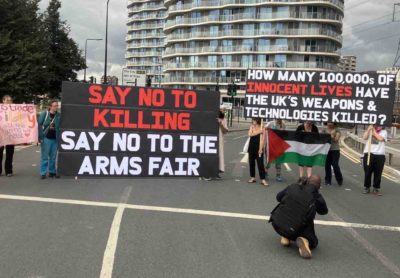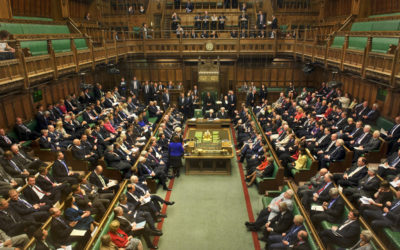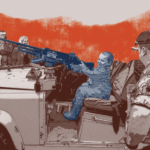What the arms fair tells us about new militarism

As well as being an arms fair, Defence and Security Equipment International (DSEI) acts as a stage from which senior military leaders and defence and trade politicians can project their latest thinking to a like-minded audience. DSEI is very much a state-sponsored event to encourage companies, governments, think-tanks and researchers to connect on strategy, partnerships and technologies. As arms trade researcher Anna Stavrianakis reminds us, ‘The costs of weapons production are socialised – but the profits are privatised.’
While there continues to be little public discussion about what goes on at DSEI enough is revealed in published speeches, the defence press and DSEI’s own communications about this ‘international defence community’ event, to provide important takeaways on the direction of defence policy that will affect us all, as well as the clearest illustration of how the interests and operations of states and the defence and security industry are deeply entwined.
Here, we take a brief look at a number of themes that have been prevalent at DSEI this year and that are key to the defence reviews and strategy documents of the last few years. Some reflect the trends we have been observing at the interface between defence interests – the military and defence industry – and other areas of society, such as the education system. Others feel more like military visions that may never be fully realised, given the scale of the practical and culture leaps required. Changing situations and developing challenges can emerge rapidly, as the recent assessments of speeches by senior military at DSEI 2021 discuss.
Only an industry so grounded in violence could, and needs to, employ such Orwellian doublespeak, overlaying its threats with vague positivity. Warfighting and surveillance as progress.
‘Defining your future’
The defence industry is very fond of using vague and ultimately meaningless phrases to promote their companies, and title their reports and websites. The DSEI headline, ‘Powering progress, defining your future’, fits this trend perfectly. Only an industry so grounded in violence could, and needs to, employ such Orwellian doublespeak, overlaying its threats with vague positivity. Warfighting and surveillance as progress. We should take the threat of this interest group defining our collective future very seriously. This is what defence interests, particularly commercial ones, would like to have more influence over for the sake of their own bottom line, aided in every possible way by a government driven by neo-liberalism mindset.
This extends to government ministers talking up the social value of the defence industry, helping them communicate a ‘positive vision of what they are achieving’. Although the new Defence Secretary, Grant Shapps, has not appeared at DSEI as would be usual, he did make a statement to Parliament warning that the requirements of investors to consider environmental, social and governance (ESG) implications risks undermining the defence industry. He rationalised that the ‘[defence] industry is driving innovation in new technologies to improve sustainability and companies are embedding ESG metrics into their remuneration structure’.

Bishop Roger Morris gives a powerful address to a blockade at a DSEI equipment gate. Criticism of the arms fair is increasingly coming from religious organisations, including the Catholic Bishops Conference for England and Wales. In 2021, the Mayor of London said DSEI organisers should reconsider the event and not come back. Photo: Anglican Pacifist Fellowship.
More integration, and controversy
The main theme of DSEI 2023 forums is ‘achieving an integrated force’, a strategy that involves the disparate parts of the defence machine working together. It is part of a wider integrating dynamic: in 2021 the Integrated Review of Security, Defence, Development and Foreign Policy conceived to bring Britain’s soft and hard power together. And the presence of military and politicians from many countries at DSEI provides an opportunity for the boundaries of integration to be pushed wider: ‘National integration of forces and capabilities is no longer sufficient; an international integrated approach is needed across allies and partners to consistently improve understanding, enable sustained global reach, and create truly disruptive capabilities.’
It was during DSEI 2021 that the government announced the AUKUS defence agreement between the UK, US and Australia, and the current show also reflects the new defence agreement the UK has made with Japan, and their joint work (with Italy) on a new generation of fighter jets under the Global Combat Air Programme (GCAP). The session titled ‘UK & Japan: the power of technology to drive strategic collaboration, enhance security and enable growth’, and sponsored by Fujitsu, states that the partnership will ‘have far-reaching consequences for both nations’.
More obviously controversial is the suggestion that Saudi Arabia has wants to join the GCAP partnership, a move supported by the UK. One DSEI session, called ‘Success in Saudi Arabia’, states that ‘the defence sector specifically has long been a prized market for exporters’. The partnership is, however, opposed by Japan and it is unclear whether it will go ahead, but it’s an early indication of how politically problematic such integrated approaches could get. Steaming on regardless, the minister for Defence Procurement, James Cartlidge, announced on Tuesday a new Partnerships Office for Strategic Defence Exports: ‘Drawing cross-Whitehall and industrial expertise together to prioritise and resource export opportunities. It will oversee the delivery of our brand new, business-backing, brand-Britain, Government-to-Government offer: UK Defence Partnerships.’
Integration beyond defence
As well as integration ‘across the five operational domains of Air, Cyber, electromagnetic activities (CEMA), Land, Sea and Space’, a key theme in current defence strategy, and very much reflected at DSEI, is integration with industry, and the research and development provided by academia. The recent Defence Command Paper states that ‘a common endeavour which places industry at the heart of the Defence Enterprise – recognising our industrial base as an essential component of our national security – will help maintain our strategic advantage.’
High levels of government aid for defence and the industrial sectors that support it are also justified by being given the status of drivers for the UK economy, ‘levelling up’ and technological innovation. This was summarised by the Chief of General Staff General, Sir Patrick Sanders, in his DSEI speech: Together, we will seize the opportunity presented by the Defence Equipment plan which gives the Army £41 billion over 10 years. Our job is to responsibly commit this money and demonstrate a return on that investment, to generate credible warfighting capability, and contribute to an increasingly vibrant industrial base, skills, and exports.’
Thus we observe the military industrial academia complex being made larger and more total.
The DSEI forums reflect defence’s long-held existential concerns about the ability to access innovation and new technology and overcome supply chain and skills deficits. The session called ‘Develop and deliver, at pace, battle winning technologies to the Warfighter’ states that ‘We must collaborate across government, academia, science, engineering and industry now.’ Accessing a wider array of industrial resources beyond the defence industry, such as through the Catapult Network for industry collaboration and via a focus on small and medium sized enterprises (SMEs), are now priorities.
Thus we observe the military industrial academia complex being made larger and more total. DSEI 2023 is touted as the largest the arms fair has ever been with a number of non-defence household names, from telecoms and tech and automotive industry, among the 1,600 exhibitors, and sponsors, as well as many small suppliers.
‘Lethal’ has become a favoured buzzword, along with ‘warfighter’ – the appeal of directness glossing over a blockbuster-inspired simplisticness and lack of reality.
Renewal of the armed forces, and their personnel
Defence strategy of late tends to envision the armed forces as rather different from what they currently are. This is reflected at DSEI in sessions such as ‘Beyond Modernisation: the Army’s route to renewal’ which states that ‘the British Army is poised to realise its vision of becoming the most advanced and lethal army in Europe’. ‘Lethal’ has become a favoured buzzword, along with ‘warfighter’ – perhaps the UK version of the US’s ‘warrior’ – the appeal of directness glossing over a blockbuster-inspired simplisticness and lack of reality.
That this language may create a tendency to treat the human as part of the machine, is illustrated in the DSEI ‘future soldier’ conference. Focusing on maximising advantage through physical performance, it is perhaps not surprising – in the new tech and alpha environment of DSEI – that mental health and human fragility are not part of the discussion.
Another DSEI session is called ‘How the British Army is optimising its people’. Given the dire summary of the current situation with regards to satisfaction levels and recruitment and retention rates published in the recent review on incentivising the armed forces, there seems to be a long way to go. Amongst its numerous recommendations, the review develops the idea of lateral entry from other professions within a more flexible ‘spectrum of service’. This would help the army to access the skills that the increasingly ‘advanced’ and technologically driven armed forces are hoping to become, harnessing yet more of society’s resources for defence.
Defence’s embracing of AI and robotics provides yet another demonstration of how the sector opportunistically exploits new frontiers, however worrying these development are for others.
The race for new frontiers – space and AI
Amongst the new technologies and new weapons, there is a particular sense of competitive urgency in the DSEI forums around space and AI. Titles such as ‘The UK – Australia space bridge: getting ahead in the global space race’, and ‘Collaborating internationally to exploit the commercialisation of space for defence’ show the propelling role of defence in this area. The government’s National Space Strategy for developing the space economy was published in 2021 and quickly followed by the MoD’s Defence Space Strategy in early 2022. The dangers of an emerging arms race in space are discussed in a recent report from Drone Wars and CND on the UK’s militarisation of space.
Defence’s embracing of AI and robotics provides yet another demonstration of how the sector opportunistically exploits new frontiers, however worrying these development are for others. Presented with a spin – ‘Artificial Intelligence will protect our democracies’ and with the need for ‘campaign advantage’, these sessions have the involvement of major corporations that we don’t usually think of as defence companies – Oracle, IBM, Fujitsu and the already controversial Palantir.
One of the most unsettling images on the DSEI website is a menacing headless robotic dog surrounded by smartly dressed delegates taking photos. Not just a threat for the future, similar ‘digidogs’ are being unleashed in New York, despite public backlash – a chilling reminder of how these technologies will impact the security and civilian space as much as traditional theatres of war.
A ‘pre-war generation’
In his keynote speech the Chief of General Staff reflected, with reference to the war in Ukraine, that ‘we are now a pre-war generation’, and that this should be our viewpoint in order to ‘ensure that we emerge more lethal, agile, expeditionary and resilient, all underpinned by our digital framework.’ In contrast, there is a relative lack of attention to the challenges of climate change and sustainability, which are reduced to operational problems to be solved but also ‘opportunities to further our operational advantage’. The renewed mission of preparing for war will clearly be dominant in public narratives around defence spending and resources in the next few years.
See more: legislation & policy, Fusion/integrated defence concept, STEM, arms trade, climate change, militarisation
Like what you read?
> Sign up for our newsletter or blog notifications
> Support our work – from just £2 a month









